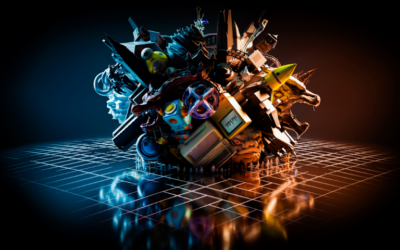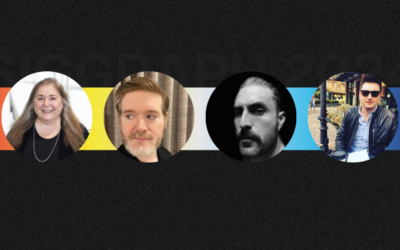Headshot of Jaden Oh
This interview was contributed to the ACM SIGGRAPH Blog by Chris Davison.
The Academy of Motion Picture Arts and Sciences (AMPAS) hosts an annual celebration known as the Scientific and Technical Awards, dedicated to honoring those whose innovations have contributed in significant and lasting ways to motion pictures. In other words, the makers of movie magic.
One such magician is Jaden Oh, who was recently honored with a Scientific and Engineering Award for his concept and development of the Marvelous Designer digital clothing creation system.
Per the Academy, Marvelous Designer “introduced a pattern-based approach to digital costume construction, unifying design and visualization.” Jaden and his team of engineers and designers at CLO Virtual Fashion allow digital wardrobe creation that has “helped to raise the quality of appearance and motion in digital wardrobe creations” and has quickly become the go-to for leading companies, including Weta Digital.
For a brief visual tour through CLO3D, watch this video.
I had a chance to interview Jaden about polygon optimization, Hugo Boss, “The Hobbit”, and real-time cloth simulation.
Chris Davison (CD): When did it first become clear that an unmet need existed, and what was your development process like?
Jaden Oh (JO): The development process for Marvelous Designer began during graduate school when I recognized the labor-intensive nature of creating digital costumes. Traditional methods involved manual sculpting and texturing, which was time-consuming and required a high level of expertise. Through research projects conducted at the time, I identified an opportunity to streamline this process. Marvelous Designer was different to existing solutions at the time, offering interactive 2D pattern and 3D garment modeling coupled with advanced real-time cloth simulation. This allowed artists and designers to create virtual garments more efficiently while achieving a high level of realism.
Early adoption by individual users and studios like Weta Digital confirmed the potential of Marvelous Designer. Subsequently, continuous feedback from users has been instrumental in innovating the software, improving its functionality and usability over time.
CD: What are some of the factors involved in the decision to go with digital costumes versus practical costumes?
JO: I initially envisaged the project to be used for both physical garments as well as virtual ones. As such, we developed a set of tools aimed at the fashion industry, which is now used by household names and brands from all over the world, including Hugo Boss, Mango, Adidas, Emilio Pucci, Arc’teryx, and Macy’s. The tech is transforming the way creators and designers work and collaborate with each other.
So ultimately, the two fields are synergizing and advancing together. In the CG industry, sophisticated garment modeling based on patterns has increased realism, while in the fashion industry, the introduction of more flexible and convenient tools has enabled creative end content generation.
CD: How do you approach nuanced character elements such as muscle and skin and hair?
JO: The fast and accurate simulation technology allows artists to visualize and refine 3D draping in real time — so the clothes behave in a lifelike manner in conjunction with any muscular and hair elements that a designer may include in the character model.
CD: Your work was a part of “The Hobbit: An Unexpected Journey”. When you first saw the completed film, how did you feel?
JO: It was thrilling to see our cloth modeling technology featured in a large, big-budget, live-action film like “The Hobbit” series. We’ve been lucky that artists and creators continue to trust Marvelous Designer as their tool of choice when it comes to garment simulations. Knowing that something we worked on has become an integral part of the filmmaking process is incredibly fulfilling and inspires further innovation and improvement. We want to ensure that we keep evolving and meeting the ever-changing needs of the industry.
CD: What excites you? What technologies are on the horizon that you are looking forward to?
JO: My team and I always approach development by envisioning how excited users will be when they see new features or technologies in action. That’s where we draw our inspiration. Thus far, our focus has been on developing modeling technologies that make it easier and more creative to design garments.
Looking ahead, Marvelous Designer is poised to expand well beyond its current 3D modeling and animation capabilities. We’re aiming to evolve it into a multifaceted tool that can handle various processes, such as rigging, polygon and texture optimization, rendering, and more. By broadening its capabilities, we envision Marvelous Designer becoming an essential tool across different stages of the creation workflow.
In the future, we’re striving to develop technologies that make it easier, almost automatic, to create game-ready costumes, animations, and other end contents after modeling the garments.
CD: What advice would you give to someone considering a scientific or technical career in the motion picture industry?
JO: Stay flexible. Marvelous Designer started out as a clothing technology intended to be used for online shopping. It took a few tries and years until people figured out ways to make it useful in movies, games, and animations. You don’t know what turns you’ll take, but dreaming big and staying nimble helped us at CLO to become what we are today.
User focused. Understanding the needs and challenges of those who will ultimately use your technology or products is paramount in the motion picture industry. By prioritizing the user experience and tailoring your innovations to address their specific requirements, you can ensure that your contributions have a meaningful impact in this dynamic field.

Chris Davison is a scientist, consultant, and public speaker and can be reached at davison@intellcap.com.



